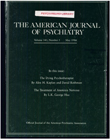Problems in the diagnosis of intermittent explosive disorder
Abstract
The authors studied the accuracy with which intermittent explosive disorder was diagnosed in a university hospital setting. An index of diagnostic features abstracted from the description of intermittent explosive disorder in DSM-III was used for chart review. Diagnosis of the disorder was made in 20 out of 830 admissions (2.4%). In 14 cases (1.7%) it was a primary one; in another five (.6%) it was secondary; and in one case (.1%) it was tertiary. The authors discuss the varied rigorousness of the diagnosis and the importance of using an index of diagnostic features to enhance diagnostic accuracy.
Access content
To read the fulltext, please use one of the options below to sign in or purchase access.- Personal login
- Institutional Login
- Sign in via OpenAthens
- Register for access
-
Please login/register if you wish to pair your device and check access availability.
Not a subscriber?
PsychiatryOnline subscription options offer access to the DSM-5 library, books, journals, CME, and patient resources. This all-in-one virtual library provides psychiatrists and mental health professionals with key resources for diagnosis, treatment, research, and professional development.
Need more help? PsychiatryOnline Customer Service may be reached by emailing [email protected] or by calling 800-368-5777 (in the U.S.) or 703-907-7322 (outside the U.S.).



